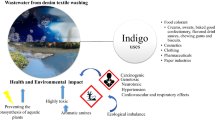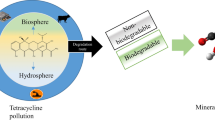Abstract
The occurrence and persistence of pharmaceutical products (PPs) in the environment have recently been well-documented and are a major concern for public health. Their incidence in aquatic ecosystems is the result of their direct release without any prior treatment or insufficient wastewater treatment. Therefore, an efficient and safe posttreatment process for removing PPs must be developed. In this study, we focused on the ability of photocatalysis or combined photocatalysis and biodegradation to effectively and safely remove diclofenac (DCF) and its by-products from water. The heterogeneous photocatalysis system was based on bio-sourced activated carbon obtained from Argania spinosa tree nutshells and Degussa P25 titanium dioxide (ACP-TiO2), and biodegradation involved Pseudomonas aeruginosa. Toxicity tests were conducted with zebrafish embryos to evaluate the applicability of the treatment processes. The results showed that photocatalytic treatment with 0.1 mg/L of ACP-TiO2 9% for 7.5 h is sufficient to eliminate DCF (50 mg L−1) and its by-products from water. Low levels of malformation (< 20%) were detected in zebrafish embryos treated with photocatalyzed DCF solutions at 1, 5, and 7 mg L−1 after 4 days of exposure. After 3 h of incubation, P. aeruginosa was found to reduce the toxicity of DCF (10 mg L−1) photocatalyzed for 2 and 4 h. Additional studies should be conducted to elucidate the biodegradation mechanism.






Similar content being viewed by others
References
Baena-Nogueras RM, González-Mazo E, Lara-Martín PA (2017) Degradation kinetics of pharmaceuticals and personal care products in surface waters: photolysis vs biodegradation. Sci Total Environ 590–591:643–654. https://doi.org/10.1016/j.scitotenv.2017.03.015
Bagal MV, Gogate PR (2014) Degradation of diclofenac sodium using combined processes based on hydrodynamic cavitation and heterogeneous photocatalysis. Ultrason Sonochem 21:1035–1043. https://doi.org/10.1016/j.ultsonch.2013.10.020
Beeman RE, Bleckmann CA (2002) Sequential anaerobic-aerobic treatment of an aquifer contaminated by halogenated organics: field results. J Contam Hydrol 57:147–159. https://doi.org/10.1016/S0169-7722(02)00008-6
Bilal M, Adeel M, Rasheed T, Zhao Y, Iqbal HMN (2019) Emerging contaminants of high concern and their enzyme-assisted biodegradation – a review. Environ Int 124:336–353. https://doi.org/10.1016/j.envint.2019.01.011
Brar SK, Verma M, Lonappan L et al (2016) Diclofenac and its transformation products: environmental occurrence and toxicity - a review. Environ Int 96:127–138. https://doi.org/10.1016/j.envint.2016.09.014
Chen JB, Gao HW, Zhang YL, et al (2014) Developmental toxicity of diclofenac and elucidation of gene regulation in zebrafish (Danio rerio). Sci Rep 4:1–7. https://doi.org/10.1038/srep04841
Coimbra RN, Otero M, Torres T et al (2018) Zebrafish embryo bioassays for a comprehensive evaluation of microalgae efficiency in the removal of diclofenac from water. Sci Total Environ 640–641:1024–1033. https://doi.org/10.1016/j.scitotenv.2018.05.353
Cristiano W, Lacchetti I, Mancini L et al (2019) Promoting zebrafish embryo tool to identify the effects of chemicals in the context of water framework directive monitoring and assessment. Microchem J 149:104035. https://doi.org/10.1016/j.microc.2019.104035
Dai YJ, Jia YF, Chen N et al (2014) Zebrafish as a model system to study toxicology. Environ Toxicol Chem 33:11–17. https://doi.org/10.1002/etc.2406
de Souza AC, Sardela VF, de Sousa VP, Pereira HMG (2018) Zebrafish (Danio rerio): a valuable tool for predicting the metabolism of xenobiotics in humans? Comp Biochem Physiol Part - C Toxicol Pharmacol 212:34–46. https://doi.org/10.1016/j.cbpc.2018.06.005
El Mouchtari EM, Daou C, Rafqah S et al (2019) TiO2 and activated carbon of Argania Spinosa tree nutshells composites for the adsorption photocatalysis removal of pharmaceuticals from aqueous solution. J Photochem Photobiol A Chem 388:112183. https://doi.org/10.1016/j.jphotochem.2019.112183
Gar Alalm M, Tawfik A, Ookawara S (2016) Enhancement of photocatalytic activity of TiO 2 by immobilization on activated carbon for degradation of pharmaceuticals. J Environ Chem Eng 4:1929–1937. https://doi.org/10.1016/j.jece.2016.03.023
Gröning J, Garten C, Schlömann M et al (2007) Transformation of diclofenac by the indigenous microflora of river sediments and identification of a major intermediate. Chemosphere 69:509–516. https://doi.org/10.1016/j.chemosphere.2007.03.037
Hallare AV, Köhler HR, Triebskorn R (2004) Developmental toxicity and stress protein responses in zebrafish embryos after exposure to diclofenac and its solvent, DMSO. Chemosphere 56:659–666. https://doi.org/10.1016/j.chemosphere.2004.04.007
Hata T, Kawai S, Okamura H, Nishida T (2010) Removal of diclofenac and mefenamic acid by the white rot fungus Phanerochaete sordida YK-624 and identification of their metabolites after fungal transformation. Biodegradation 21:681–689. https://doi.org/10.1007/s10532-010-9334-3
Hoeger B, Köllner B, Dietrich DR, Hitzfeld B (2005) Water-borne diclofenac affects kidney and gill integrity and selected immune parameters in brown trout (Salmo trutta f. fario). Aquat Toxicol 75:53–64. https://doi.org/10.1016/j.aquatox.2005.07.006
Jamil TS, Ghaly MY, Fathy NA et al (2012) Enhancement of TiO 2 behavior on photocatalytic oxidation of MO dye using TiO 2/AC under visible irradiation and sunlight radiation. Sep Purif Technol 98:270–279. https://doi.org/10.1016/j.seppur.2012.06.018
Kanakaraju D, Glass BD, Oelgemöller M (2018) Advanced oxidation process-mediated removal of pharmaceuticals from water: a review. J Environ Manag 219:189–207. https://doi.org/10.1016/j.jenvman.2018.04.103
Kaur A, Umar A, Kansal SK (2016) Heterogeneous photocatalytic studies of analgesic and non-steroidal anti-inflammatory drugs. Appl Catal A Gen 510:134–155. https://doi.org/10.1016/j.apcata.2015.11.008
Lim TT, Yap PS, Srinivasan M, Fane AG (2011) TiO2/AC composites for synergistic adsorption-photocatalysis processes: present challenges and further developments for water treatment and reclamation. Crit Rev Environ Sci Technol 41:1173–1230. https://doi.org/10.1080/10643380903488664
Lin AY-C, Reinhard M (2005) Photodegradation of common environmental pharmaceuticals and estrogens in river water. Environ Toxicol Chem 24:1303–1309. https://doi.org/10.1897/04-236R.1
Luo Y, Guo W, Ngo HH, Nghiem LD, Hai FI, Zhang J, Liang S, Wang XC (2014) A review on the occurrence of micropollutants in the aquatic environment and their fate and removal during wastewater treatment. Sci Total Environ 473–474:619–641. https://doi.org/10.1016/j.scitotenv.2013.12.065
MARTINKOVA L, NESVERA J, UHNAKOVA B et al (2008) Biodegradation potential of the genus Rhodococcus. Environ Int 35:162–177. https://doi.org/10.1016/j.envint.2008.07.018
Meribout R, Zuo Y, Khodja AA et al (2016) Photocatalytic degradation of antiepileptic drug carbamazepine with bismuth oxychlorides (BiOCl and BiOCl/AgCl composite) in water: efficiency evaluation and elucidation degradation pathways. J Photochem Photobiol A Chem 328:105–113. https://doi.org/10.1016/j.jphotochem.2016.04.024
Moreira IS, Bessa VS, Murgolo S, Piccirillo C, Mascolo G, Castro PML (2018) Biodegradation of Diclofenac by the bacterial strain Labrys portucalensis F11. Ecotoxicol Environ Saf 152:104–113. https://doi.org/10.1016/j.ecoenv.2018.01.040
Murray KE, Thomas SM, Bodour AA (2010) Prioritizing research for trace pollutants and emerging contaminants in the freshwater environment. Environ Pollut 158:3462–3471. https://doi.org/10.1016/j.envpol.2010.08.009
Oecd/Ocde (1992) Oecd guideline for the testing of chemicals. Guidel Test Chem 8:1–8. https://doi.org/10.1787/9789264070684-en
Omri A, Benzina M (2015) Influence of the origin of carbon support on the structure and properties of TiO<inf>2</inf> nanoparticles prepared by dip coating method. Arab J Chem. https://doi.org/10.1016/j.arabjc.2015.06.027
Pohl J, Ahrens L, Carlsson G, Golovko O, Norrgren L, Weiss J, Örn S (2019) Embryotoxicity of ozonated diclofenac, carbamazepine, and oxazepam in zebrafish (Danio rerio). Chemosphere 225:191–199. https://doi.org/10.1016/j.chemosphere.2019.03.034
Poirier-Larabie S, Segura PA, Gagnon C (2016) Degradation of the pharmaceuticals diclofenac and sulfamethoxazole and their transformation products under controlled environmental conditions. Sci Total Environ 557–558:257–267. https://doi.org/10.1016/j.scitotenv.2016.03.057
Rosales E, Diaz S, Pazos M, Sanromán MA (2019) Comprehensive strategy for the degradation of anti-inflammatory drug diclofenac by different advanced oxidation processes. Sep Purif Technol 208:130–141. https://doi.org/10.1016/j.seppur.2018.04.014
Thelusmond JR, Kawka E, Strathmann TJ, Cupples AM (2018) Diclofenac, carbamazepine and triclocarban biodegradation in agricultural soils and the microorganisms and metabolic pathways affected. Sci Total Environ 640–641:1393–1410. https://doi.org/10.1016/j.scitotenv.2018.05.403
Tran NH, Urase T, Ngo HH, Hu J, Ong SL (2013) Insight into metabolic and cometabolic activities of autotrophic and heterotrophic microorganisms in the biodegradation of emerging trace organic contaminants. Bioresour Technol 146:721–731. https://doi.org/10.1016/j.biortech.2013.07.083
Van Grieken R, Aguado J, López-Muoz MJ, Marugán J (2002) Synthesis of size-controlled silica-supported TiO2photocatalysts. J Photochem Photobiol A Chem 148:315–322. https://doi.org/10.1016/S1010-6030(02)00058-8
Veuskens T, Langenhoff A, Blokland M et al (2013) Microbial removal of the pharmaceutical compounds ibuprofen and diclofenac from wastewater. Biomed Res Int 2013:1–9. https://doi.org/10.1155/2013/325806
Wu W, Jin Y, Bai F, Jin S (2015) Pseudomonas aeruginosa. Elsevier Ltd
Xia L, Zheng L, Zhou JL (2017) Effects of ibuprofen, diclofenac and paracetamol on hatch and motor behavior in developing zebrafish (Danio rerio). Chemosphere 182:416–425. https://doi.org/10.1016/j.chemosphere.2017.05.054
Xiong JQ, Kurade MB, Jeon BH (2018) Can microalgae remove pharmaceutical contaminants from water? Trends Biotechnol 36:30–44. https://doi.org/10.1016/j.tibtech.2017.09.003
Zhang K, Yuan G, Werdich AA, Zhao Y (2019) Ibuprofen and diclofenac impair the cardiovascular development of zebrafish (Danio rerio) at low concentrations. Environ Pollut 113613. https://doi.org/10.1016/j.envpol.2019.113613
Funding
The authors gratefully acknowledge the financial support provided by the University Agency of Francophonie (AUF) – Middle East Regional Office as part of program PCSI (Interuniversity Scientific Cooperation Projects 2016-2018).
Author information
Authors and Affiliations
Corresponding author
Additional information
Responsible editor: Philippe Garrigues
Publisher’s note
Springer Nature remains neutral with regard to jurisdictional claims in published maps and institutional affiliations.
Rights and permissions
About this article
Cite this article
Daou, C., Hamade, A., El Mouchtari, E.M. et al. Zebrafish toxicity assessment of the photocatalysis-biodegradation of diclofenac using composites of TiO2 and activated carbon from Argania spinosa tree nutshells and Pseudomonas aeruginosa. Environ Sci Pollut Res 27, 17258–17267 (2020). https://doi.org/10.1007/s11356-020-08276-4
Received:
Accepted:
Published:
Issue Date:
DOI: https://doi.org/10.1007/s11356-020-08276-4




